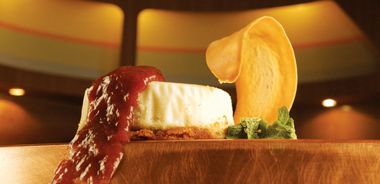Individual Créme Fraiche Cheesecakes with Rhubarb Compote

Creamy, sweet, and tart, this dessert is destined to become a favourite. You can buy créme fraiche or make your own by combining 1 Tbsp (15 mL) buttermilk with 2 cups (.5 L) whipping cream. Let this mixture sit uncovered on kitchen counter for 24 hours. Refrigerate overnight and you have créme fraiche.
Graham Crust
2/3 cup (150 mL) graham cracker crumbs
1/4 cup (60 mL) walnuts
2 Tbsp (30 mL) melted butter
1 Tbsp (15 mL) organic sugar
Pinch of cinnamon (optional)
Cheesecake Filling
1 lb (500 g) cream cheese
1/2 cup (100 g) organic sugar
1 Tbsp (15 g) unbleached flour
3 drops natural vanilla extract
1 free-range egg
1/2 cup (100 g) créme fraiche
Rhubarb Compote
2 cups (500 mL) chopped organic rhubarb
1 cup (250 mL) water
1/4 cup (60 mL) organic sugar
Juice of half an organic lemon
1 Tbsp (15 mL) chopped ginger
As baking containers, choose 4 cans that are about 2 to 2-1/2 inches (5 to 6 cm) tall; for example, use empty canned pineapple tins. Remove both ends and the label, and wash each can. Line with parchment paper and place cans on baking tray.
Preheat oven to 375 F (190 C). Combine all ingredients for Graham Crust and divide mixture among 4 cans, tamping each down with bottom of a glass or bottle that fits just inside the can. Bake 15 minutes.
Reduce oven temperature to 250 F (120 C). Beat cream cheese, sugar, and flour until light and fluffy. Add egg and scrape down bowl. Add vanilla and créme fraiche. Scrape bowl and continue to mix at medium speed. Divide mixture among 4 prepared cans. Bake 1 hour. Turn off oven and allow cheesecakes to cool in oven for another hour. Remove from oven and run a knife between can and parchment paper. Lift cans and gently unwrap paper from cheesecakes.
Meanwhile place all ingredients for Rhubarb Compote in saucepan and simmer until soft, about 30 minutes. Chill and serve on cheesecakes. Garnish with mint.
source: "Open to Inspiration", alive #284, June 2006




